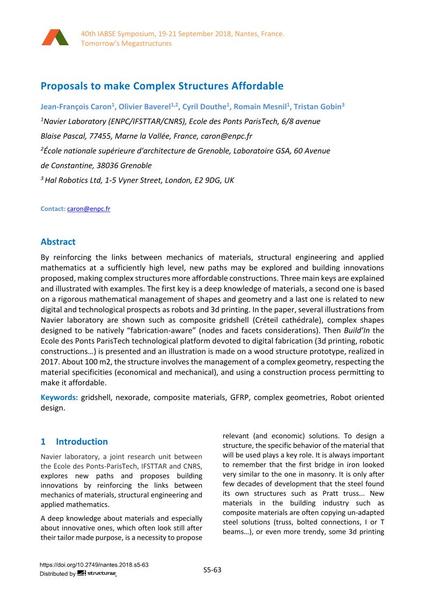Proposals to make Complex Structures Affordable

|
|
|||||||||||
Bibliographic Details
| Author(s): |
Jean-François Caron
(Navier Laboratory (ENPC/IFSTTAR/CNRS), Ecole des Ponts ParisTech, 6/8 avenue Blaise Pascal, 77455, Marne la Vallée, France)
Olivier Baverel (Navier Laboratory (ENPC/IFSTTAR/CNRS), Ecole des Ponts ParisTech, 6/8 avenue Blaise Pascal, 77455, Marne la Vallée, France; École nationale supérieure d'architecture de Grenoble, Laboratoire GSA, 60 Avenue de Constantine, 38036 Grenoble) Cyril Douthe (Navier Laboratory (ENPC/IFSTTAR/CNRS), Ecole des Ponts ParisTech, 6/8 avenue Blaise Pascal, 77455, Marne la Vallée, France) Romain Mesnil (Navier Laboratory (ENPC/IFSTTAR/CNRS), Ecole des Ponts ParisTech, 6/8 avenue Blaise Pascal, 77455, Marne la Vallée, France) Tristan Gobin (Hal Robotics Ltd, 1-5 Vyner Street, London, E2 9DG, UK) |
||||
|---|---|---|---|---|---|
| Medium: | conference paper | ||||
| Language(s): | English | ||||
| Conference: | IABSE Symposium: Tomorrow’s Megastructures, Nantes, France, 19-21 September 2018 | ||||
| Published in: | IABSE Symposium Nantes 2018 | ||||
|
|||||
| Page(s): | S5-63 | ||||
| Total no. of pages: | 8 | ||||
| DOI: | 10.2749/nantes.2018.s5-63 | ||||
| Abstract: |
By reinforcing the links between mechanics of materials, structural engineering and applied mathematics at a sufficiently high level, new paths may be explored and building innovations proposed, making complex structures more affordable constructions. Three main keys are explained and illustrated with examples. The first key is a deep knowledge of materials, a second one is based on a rigorous mathematical management of shapes and geometry and a last one is related to new digital and technological prospects as robots and 3d printing. In the paper, several illustrations from Navier laboratory are shown such as composite gridshell (Créteil cathédrale), complex shapes designed to be natively “fabrication-aware” (nodes and facets considerations). ThenBuild’Inthe Ecole des Ponts ParisTech technological platform devoted to digital fabrication (3d printing, robotic constructions…) is presented and an illustration is made on a wood structure prototype, realized in 2017. About 100 m², the structure involves the management of a complex geometry, respecting the material specificities (economical and mechanical), and using a construction process permitting to make it affordable. |
||||
| Keywords: |
GFRP composite materials gridshell nexorade complex geometries Robot oriented design
|
||||
